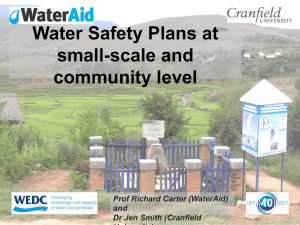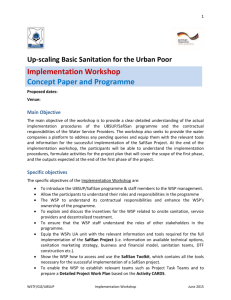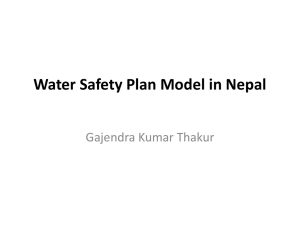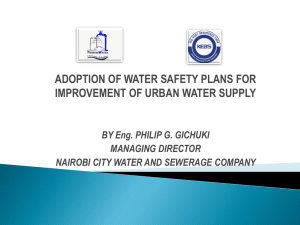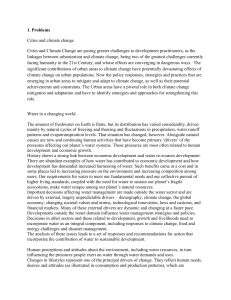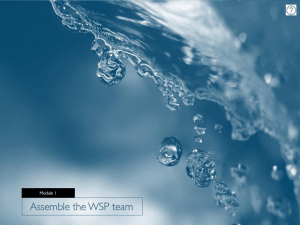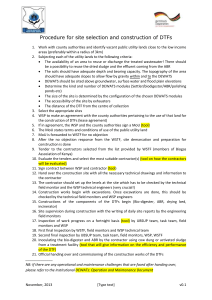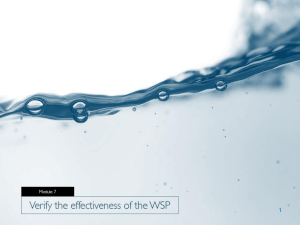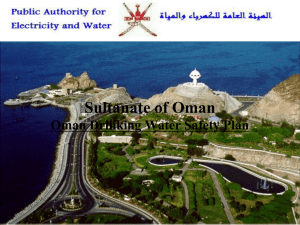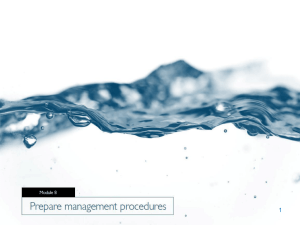A Conceptual Framework to Evaluate the Outcomes and Impacts of
advertisement
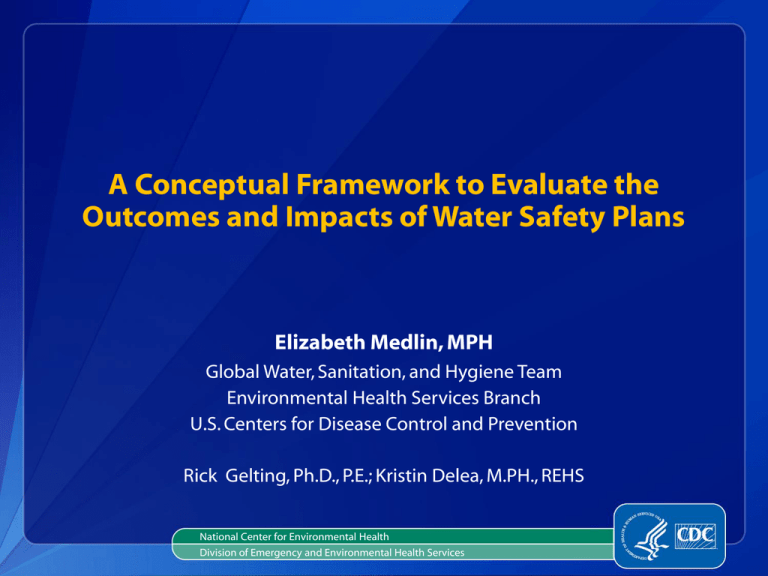
A Conceptual Framework to Evaluate the Outcomes and Impacts of Water Safety Plans Elizabeth Medlin, MPH Global Water, Sanitation, and Hygiene Team Environmental Health Services Branch U.S. Centers for Disease Control and Prevention Rick Gelting, Ph.D., P.E.; Kristin Delea, M.PH., REHS National Center for Environmental Health Division of Emergency and Environmental Health Services WHO Framework for Safe Drinking Water Public health context and health outcomes Health-based targets Water Safety Plans System Assessment Monitoring Surveillance Management & Communication WHO Framework for Safe Drinking Water Public health context and health outcomes Health-based targets Water Safety Plans System Assessment Monitoring Surveillance Management & Communication Purposes of a WSP Conceptual Framework • Varied outcomes and impacts of WSPs • Common framework and terminology • Basis for the development of indicators • Common understanding of the time frames • Various benefits of implementing WSPs Logic Models Logic Model Development Guide – WK Kellogg Foundation Logic Models Health-based targets Public health context and health outcomes Water Safety Plans System Assessment Monitoring Surveillance Management & Communication Logic Model WSP Conceptual Framework Inputs Water Safety Plan • Stakeholders Preparation •Champion • Staff / Management • Time Commitment •Facilities • Materials / Equipment System Assessment Institutional Changes Operational Changes Feedback & Improvement Monitoring & Evaluation •Knowledge •Political Will / Motivation Impacts Feedback Feedback Feedback • Water Supplier Outcomes Activities/Outputs Management & Communication Water Supply Improvements Health Improvements Other Financial Changes Environmental Factors (Sanitation, Hygiene, Food, etc.) Policy Changes Socioeconomic Improvements •Funds Months Years WSP Conceptual Framework Inputs Water Safety Plan • Stakeholders Preparation •Champion • Staff / Management • Time Commitment •Facilities • Materials / Equipment System Assessment Institutional Changes Operational Changes Feedback & Improvement Monitoring & Evaluation •Knowledge •Political Will / Motivation Impacts Feedback Feedback Feedback • Water Supplier Outcomes Activities/Outputs Management & Communication Water Supply Improvements Health Improvements Other Environmental Factors (Sanitation, Hygiene, Food, etc.) Financial Changes Policy Changes Socioeconomic Improvements •Funds Months Years WSP Conceptual Framework Inputs Stakeholders and partners Water supplier Institutional partners Less traditional partners Champion Time commitment, Facilities, Equipment Funds Motivation WSP Conceptual Framework Inputs Water Safety Plan • Stakeholders Preparation •Champion • Staff / Management • Time Commitment •Facilities • Materials / Equipment System Assessment Institutional Changes Operational Changes Feedback & Improvement Monitoring & Evaluation •Knowledge •Political Will / Motivation Impacts Feedback Feedback Feedback • Water Supplier Outcomes Activities/Outputs Management & Communication Water Supply Improvements Health Improvements Other Financial Changes Environmental Factors (Sanitation, Hygiene, Food, etc.) Policy Changes Socioeconomic Improvements •Funds Months Years WSP Conceptual Framework Activities / Outputs Motivation WSP WSP Conceptual Framework Inputs Water Safety Plan • Stakeholders Preparation •Champion • Staff / Management • Time Commitment •Facilities • Materials / Equipment System Assessment Institutional Changes Operational Changes Feedback & Improvement Monitoring & Evaluation •Knowledge •Political Will / Motivation Impacts Feedback Feedback Feedback • Water Supplier Outcomes Activities/Outputs Management & Communication Water Supply Improvements Health Improvements Other Financial Changes Environmental Factors (Sanitation, Hygiene, Food, etc.) Policy Changes Socioeconomic Improvements •Funds Months Years WSP Conceptual Framework Outcomes Institutional Changes Four Categories: Institutional Change Operational Change Financial Change Policy Change Operational Changes Financial Changes Policy Changes Different time scales Outcomes Institutional Change Institutional Changes Increased communication WSP in Guyana brought together the water supplier and the drinking water Operational regulator: Changes Increased knowledge Relations Financial Changes Improved perceptions and attitudes Communications Policy Changes Increased training Coordination of efforts Gelting, 2008, unpublished Outcomes Operational Change Institutional Changes WSP in Bangladesh identified a need for ACTION by operators to: Improved system direct infrastructure Operational Changes -repair damaged water source Implementation of improved infrastructure Financial Changes procedures -move sources of contamination Policy Changes -clean the surroundings of the water supplies Mahmud et al, 2007 Outcomes Financial Change Cost savings Institutional Changes WSP in Jamaica: Operational Changes ”…Utility and government are wellprepared to implement and sustain donor-financed improvements.” Financial Changes Increased donor support and investment “WSPs provide a new stage for funding Policy Changes assistance.” Cost recovery Environmental & Engineering Managers, Ltd, 2007 Outcomes Policy Change WSP in Jamaica: Informal WSP knowledge-sharing and promotion WSP Success WSP model sharing as norms of practice Institutional Changes WSPs as requirement in regulations Operational Changes Financial Changes 8 to 10 years Policy Changes WSP formal regulatory requirements Environmental & Engineering Managers, Ltd, 2007 WSP Conceptual Framework Inputs Water Safety Plan • Stakeholders Preparation •Champion • Staff / Management • Time Commitment •Facilities • Materials / Equipment System Assessment Institutional Changes Operational Changes Feedback & Improvement Monitoring & Evaluation •Knowledge •Political Will / Motivation Impacts Feedback Feedback Feedback • Water Supplier Outcomes Activities/Outputs Management & Communication Water Supply Improvements Health Improvements Other Environmental Environmenta lFactors Factors (Sanitation, Hygiene, Food, etc.) Financial Changes Policy Changes Socioeconomic Improvements •Funds Months Years WSP Conceptual Framework Inputs Water Safety Plan • Stakeholders Preparation •Champion • Staff / Management • Time Commitment •Facilities • Materials / Equipment System Assessment Institutional Changes Operational Changes Feedback & Improvement Monitoring & Evaluation •Knowledge •Political Will / Motivation Impacts Feedback Feedback Feedback • Water Supplier Outcomes Activities/Outputs Management & Communication Water Supply Improvements Health Improvements Other Financial Changes Environmental Factors (Sanitation, Hygiene, Food, etc.) Policy Changes Socioeconomic Improvements •Funds Months Years THANK YOU FOR YOUR ATTENTION! For more information please contact Centers for Disease Control and Prevention 1600 Clifton Road NE, Atlanta, GA 30333 Telephone, 1-800-CDC-INFO (232-4636)/TTY: 1-888-232-6348 E-mail: cdcinfo@cdc.gov Web: www.cdc.gov The findings and conclusions in this report are those of the authors and do not necessarily represent the official position of the Centers for Disease Control and Prevention. National Center for Environmental Health Division of Emergency and Environmental Health Services
